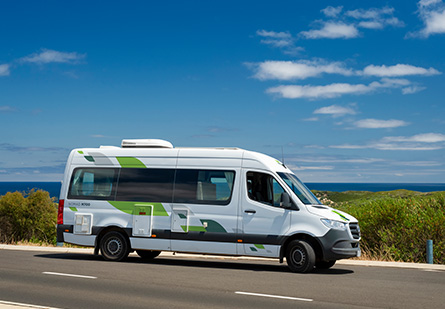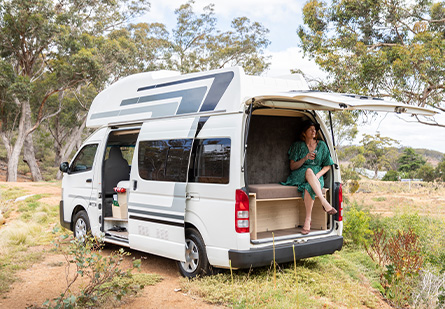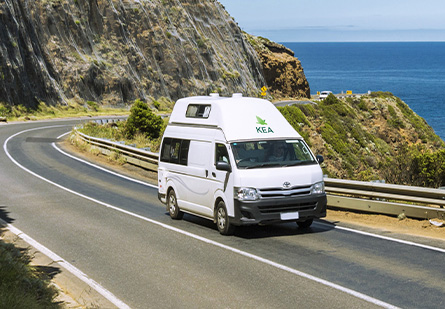
KEA Motorhomes | Better By Design & Experience
With over 25 years of experience, KEA Motorhomes are proudly built in Australia and New Zealand, and they are a proud dealership network partner of the Apollo RV Super Centre. Their KEA RV range includes six 2-berth to 6-berth motorhome models and a Hi Top 2-berth campervan for adventure-seeking solo travellers, couples, ‘silver gypsies’, and families. Good journeys are made great with the KEA Difference!

KEA 2 & 3 berth Motorhomes
Ideal for solos, couples and small families, this compact KEA range includes the Ultima and the Nomad.

KEA 4-berth Motorhomes
KEA’s 4-berth motorhomes are perfect for larger groups, and include the Navigator and the Discovery.

KEA 6-berth Motorhomes
The River and Platinum River offer room for family and friends, with all the comforts of home.

KEA Campervans - HiTop T490
This is the current KEA campervan offering, which is built on an efficient Toyota Hiace chassis.
KEA FAQs
Kea Motorhomes focuses on quality in every detail. This means they design, make and maintain every KEA motorhome to meet our unique Australian conditions. They offer multiple options of vehicle models, ages and price points; from pre-owned 2-berths to brand new 6-berths. Every KEA Motorhome is manufacturer-approved and carefully maintained to ensure a longer lifetime of adventures, and they can customise your vehicle to suit your unique travel style. They are passionate about the products they share and dedicated to delivering the KEA quality standard across each vehicle’s total lifetime. They bring honest advice to every step because, just like their motorhomes, they are here for good.
Many factors can affect a motorhome’s fuel efficiency, including weight, tyre pressure, air resistance, driving speed, and how well the engine has been maintained. Driving style can also play a role — steady, smooth driving is more fuel-efficient than braking and frequent acceleration. Ensuring your RV is operating at maximum efficiency can also be relevant. Your engine should be working correctly, oil levels should be adequate, oil should be clean, and small details like drag from the cabin should be monitored.
As a general rule, yes, as long as it doesn’t obstruct others and you follow your state's relevant parking laws. However, because your RV is wider, longer and higher than a car, you’ll need to take extra care when parking. Try not to park too close to an intersection where the height of your motorhome could obstruct the view of other drivers. If you’re still getting used to parking, choose a generously sized spot where you won’t feel rushed or overwhelmed. ‘Freedom’ parking (at night, on the side of the road) is different. You can’t just park where it suits you, and in Australia, freedom camping is only allowed in permitted areas. Check local council websites for details.
Essentially, no. The experience can be quite different, and it can take some time to get used to if you’re not experienced with larger vehicles. But the good news is, with a bit of practice (and some confidence), you’ll be driving like a pro. The key is to take your time and practice driving somewhere quiet first where you won’t feel under pressure. A few tips — get used to taking corners wider and slower, take care when trying to fit into tight parks or doing a three-point turn, and practice reversing (a lot). A motorhome is also heavier than the car you may be used to driving, so allow more time to break, maintain a safe speed, and keep a safe distance from other vehicles. And remember the height of your motorhome! Look for cantilever awnings, height indicator signs, and overhanging tree branches.
Giving your motorhome a regular interior and exterior clean is vital. Wipe down surfaces and bench tops, sweep and vacuum, and sanitise your toilet and bathroom regularly. Don’t forget to include things like upholstery, awnings, blinds, curtain tracks and anywhere else dirt and dust can collect. Washing down its exterior will also prevent the build-up of debris and dust and allow you to check for any external damage that might need seeing. However, in order for you to get the most out of your motorhome, you should book a regular service (annually at a minimum but more frequently if you use your vehicle often). This will reduce the chance of anything significant going wrong and helps keep you safe as you travel. It’s also recommended that you include a check on your motorhome’s appliances, such as the freezer/fridge, oven, and other electrical equipment in your service.